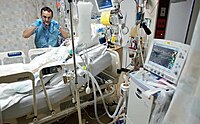
Photo from wikipedia
It is well known that oxidative stress causes certain diseases and organ damage. However, roles of oxidative stress in the acute phase of critical patients remain to be elucidated. This… Click to show full abstract
It is well known that oxidative stress causes certain diseases and organ damage. However, roles of oxidative stress in the acute phase of critical patients remain to be elucidated. This study aimed to investigate the balance of oxidative and antioxidative system and to clarify the association between oxidative stress and mortality in critically ill patients. This cohort study enrolled 247 patients transported to our emergency department by ambulance. Blood was drawn on hospital arrival, and serum derivatives of reactive oxidant metabolites (dROMs, oxidative index) and biological antioxidant potential (BAP, antioxidative index) were measured. Modified ratio (MR) is also calculated as BAP/dROMs/7.51. There were 197 survivors and 50 non-survivors. In the non-survivors, dROMs were significantly lower (274 vs 311, p<0.01), BAP was significantly higher (2,853 vs 2,138, p<0.01), and MR was significantly higher (1.51 vs 0.92, p<0.01) compared to those in the survivors. The AUC of MR was similar to that for the APACHE II score. Contrary to our expectations, higher BAP and lower dROMs were observed on admission in non-survivors. This may suggest that the antioxidative system is more dominant in the acute phase of severe insults and that the balance toward a higher antioxidative system is associated with mortality.
Journal Title: Journal of Clinical Biochemistry and Nutrition
Year Published: 2023
Link to full text (if available)
Share on Social Media: Sign Up to like & get
recommendations!